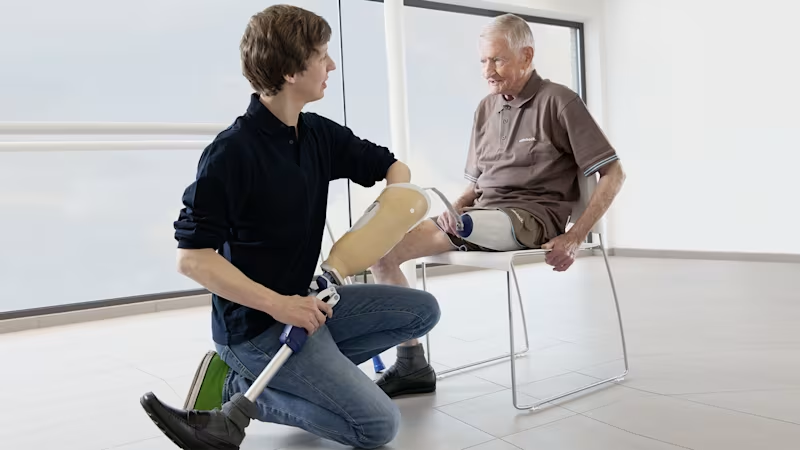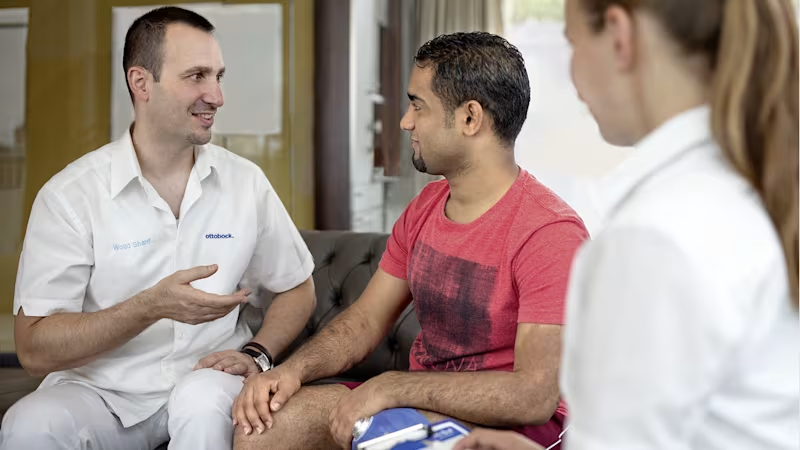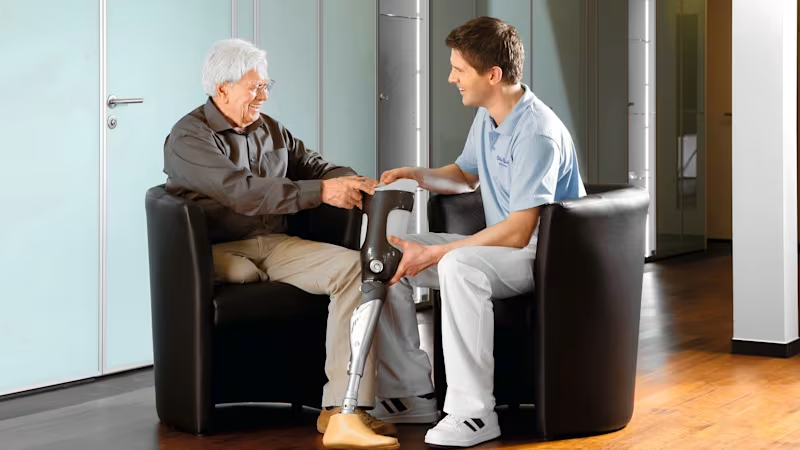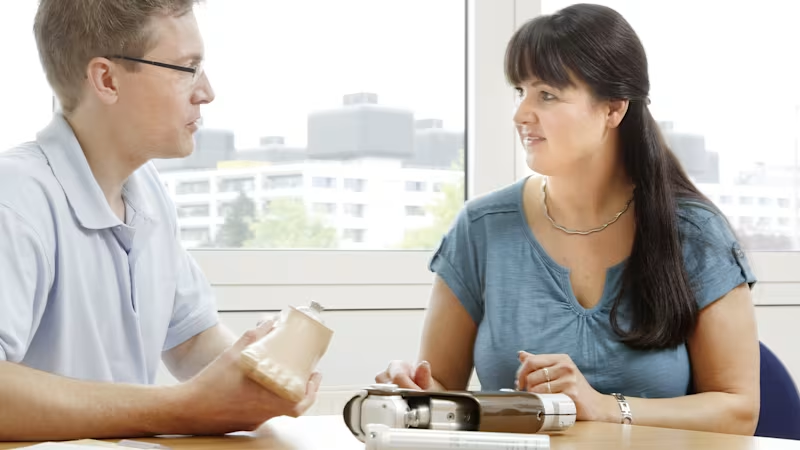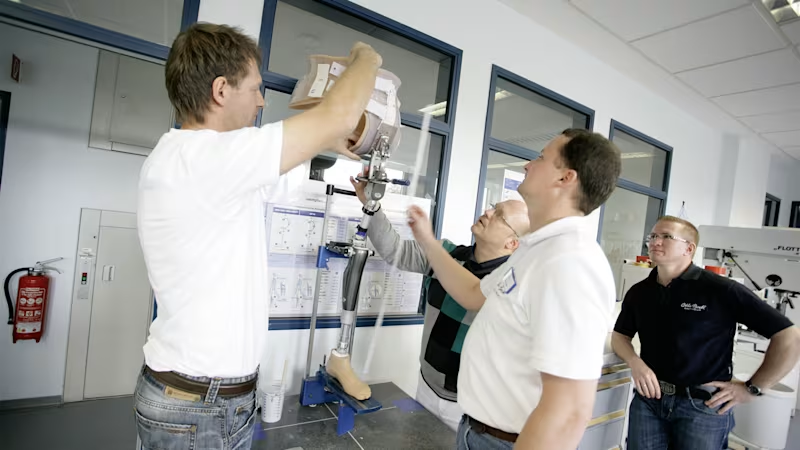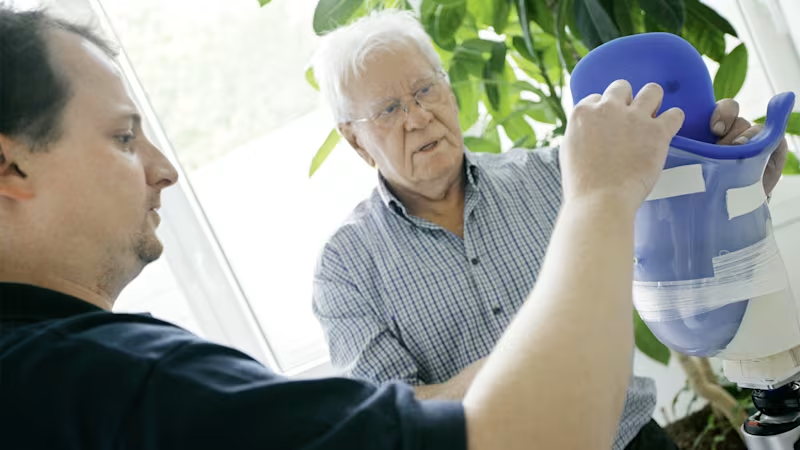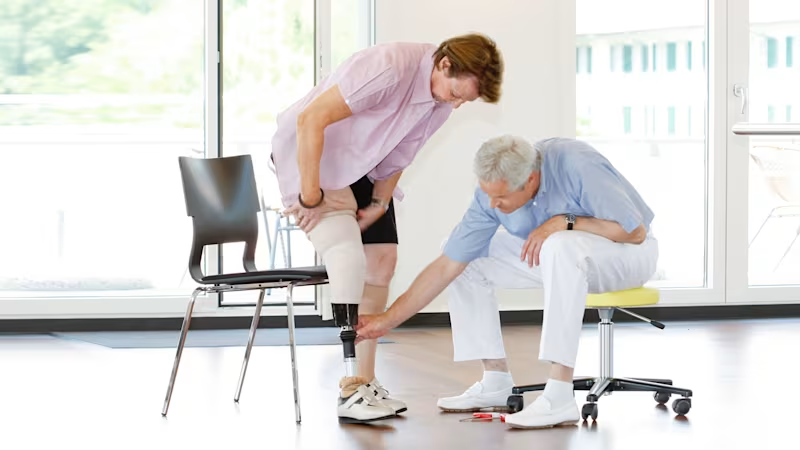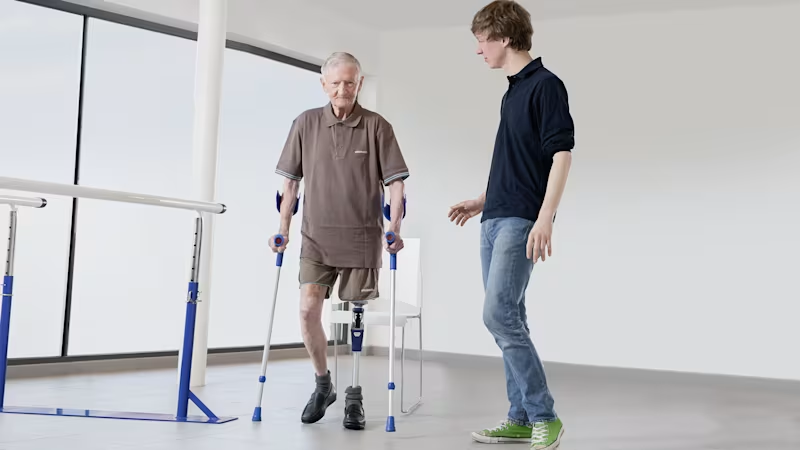
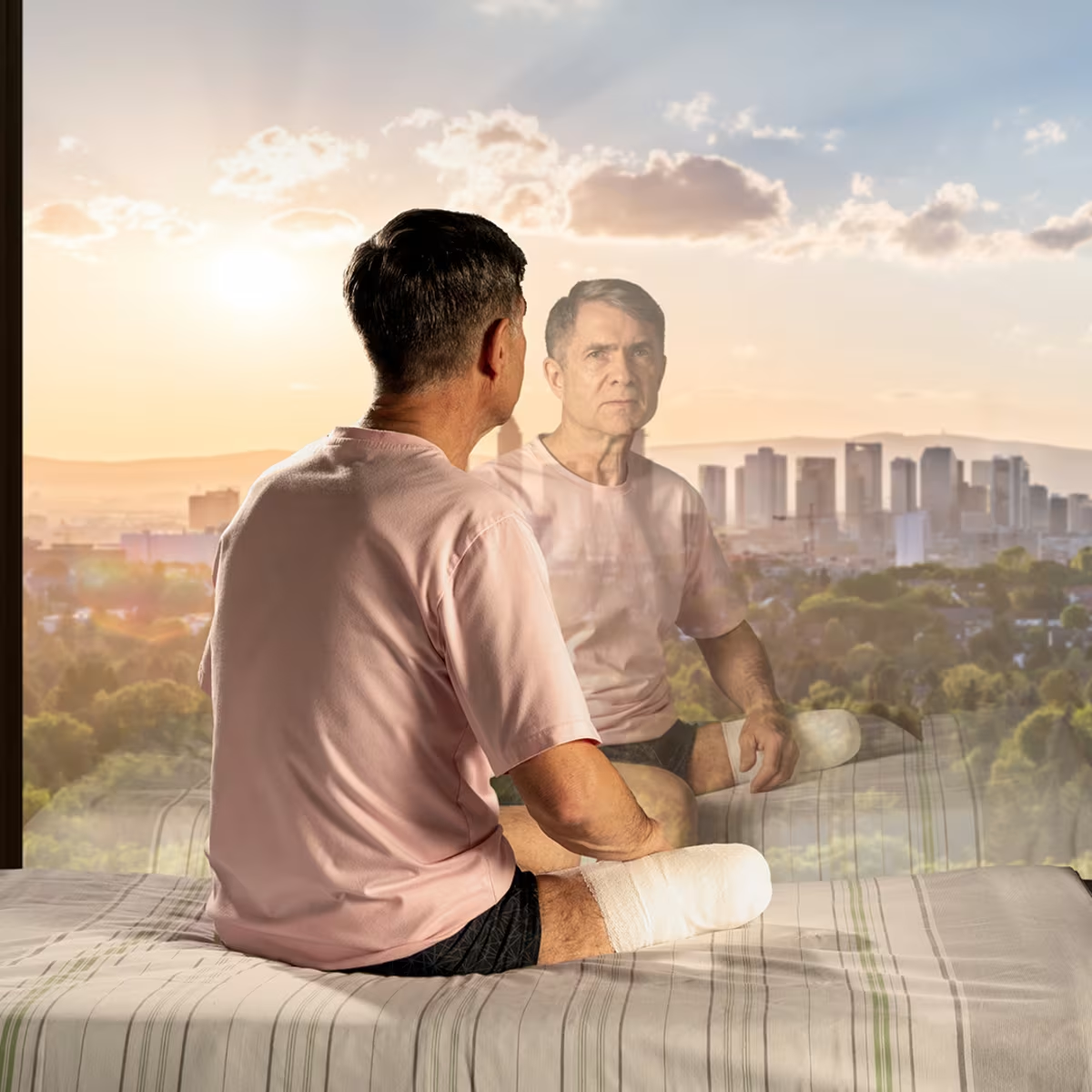
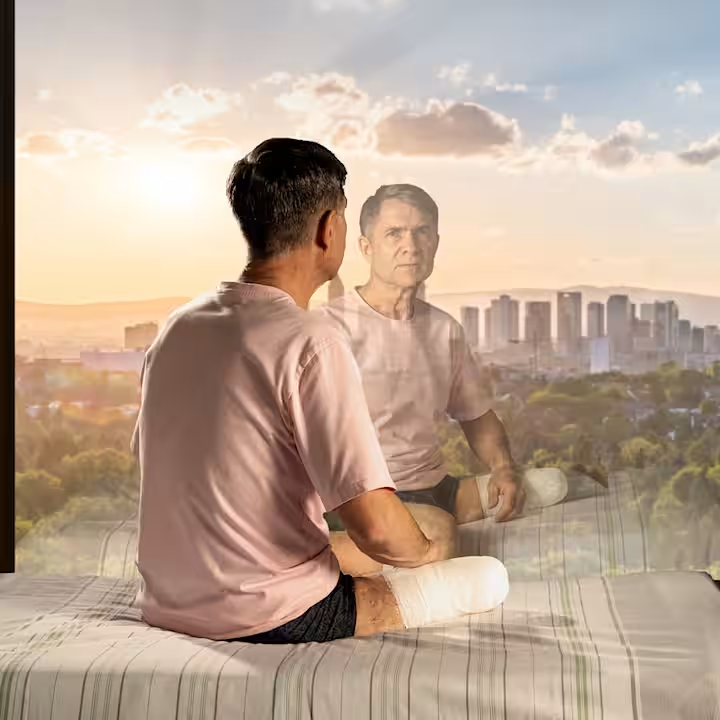
After the leg amputation (1)
Read about residual limb healing, phantom pain, initial exercises after the amputation and the fitting with an interim and definitive prosthesis.
Read about residual limb healing, phantom pain, initial exercises after the amputation and the fitting with an interim and definitive prosthesis.
What lies ahead for you after the amputation? (1)
After an amputation, you are undoubtedly wondering: What happens next? Directly after the operation, your recovery and the healing of the residual limb are initially the main concerns. Both are important so that you can begin with rehabilitation soon and a prosthesis can be fitted.
To start rehabilitation:
You should have little to no pain in the residual limb
Your residual limb should be capable of bearing weight
Swelling and water retention should have gone down and stabilised
You should be able to move your residual limb as much as possible in all directions
Your personal situation will determine how long it takes you to reach this point. However, you can promote healing by actively working towards it. While this often demands patience and a lot of endurance, it pays off: The more mobile you are when you start rehabilitation, the sooner you can be fitted with a prosthesis.
You should also use the time after the amputation in the hospital to choose a suitable clinic for your rehabilitation phase in cooperation with your O&P professional. Our list of experts helps you find facilities that specialise in working with amputees.
Préparez votre moignon au port d’une prothèse (1)
La cicatrisation de votre moignon après une amputation de jambe constitue la base de l’appareillage prothétique ensuite réalisé et joue donc un rôle crucial. À l’hôpital, les médecins surveillent et contrôlent en permanence le processus de cicatrisation tandis que le personnel infirmier s’occupe des soins quotidiens de votre moignon. Ces derniers incluent entre autres la thérapie de réduction de l’œdème, la thérapie de compression ainsi que la désensibilisation de la peau et les soins de la cicatrice.
Residual limb healing (1)
Residual limb pain (1)
Various types of pain may occur in your residual limb after an amputation. These may include bone pain, wound pain, nerve pain or phantom pain. Each type of pain is treated according to its cause. Various treatment options are available, such as medication, warming/cooling or wrapping the residual limb. You can talk to your specialist and/or pain therapist about this.
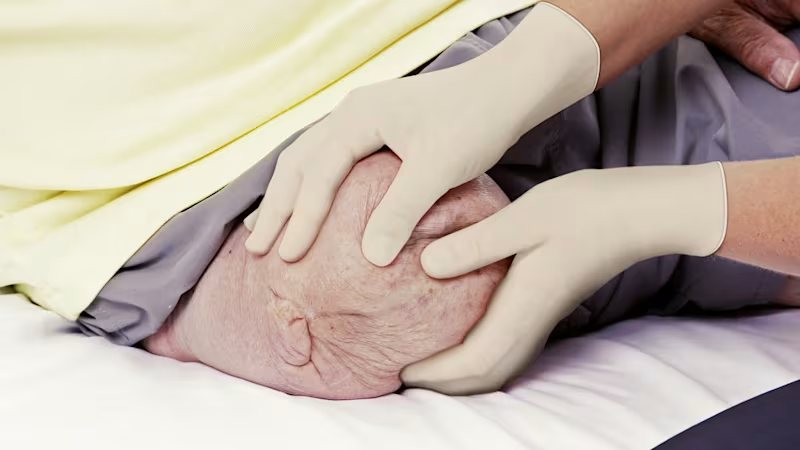
Wound healing (1)
When you wake up from the anaesthetic, your leg will usually already have a dressing consisting of simple bandages or a cast with a small tube coming out of it. This tube was inserted into the wound during the operation in order to drain fluid and blood from the wound. Known as drainage, it is removed in the course of healing. The initial wound healing phase is usually completed within the first fourteen days, when the wound has closed. After this, the connective tissue cells grow stronger and are converted into specific connective tissue. But even if the scar appears to have healed well from the outside and only the colour of the scar tissue changes slightly from this point on, the overall scar healing process takes much longer. It can take up to one and a half years before it is fully healed beneath the skin. The duration of the wound healing process depends on your individual constitution.
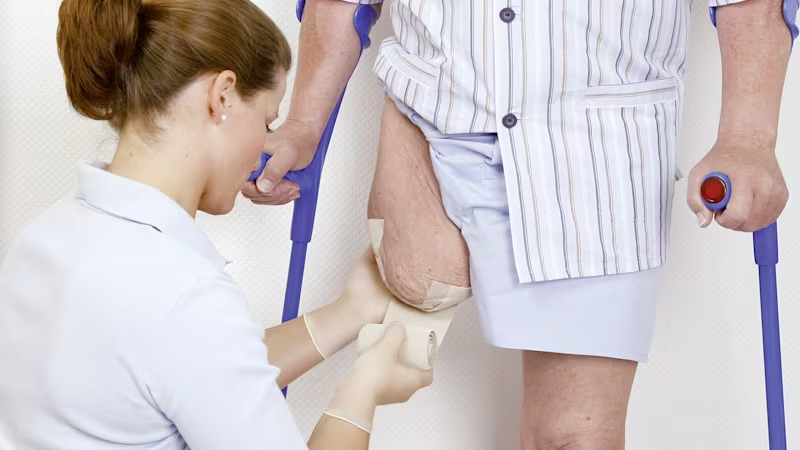
Oedema therapy (1)
After the operation, the tissue around the residual limb will usually swell up at first. This swelling (oedema) is a normal reaction to the operation. It usually subsides after about one week. Only a loose wound dressing is applied until the sutures are removed. No pressure can be applied to the residual limb at first.
The circumference of the residual limb should be measured regularly to evaluate how the swelling is going down. The same measuring points always have to be used for this, and the results must be documented on measurement forms. If this isn’t done, the results are not comparable with each other and there is no way to tell whether the swelling is decreasing.
Compression therapy (1)
Early compression therapy
After the operation, a wound dressing is applied and changed at regular intervals. Compression therapy begins after that, for example, with a compression bandage. Your doctor will determine the exact timing. The purpose of compression therapy is to reduce the residual limb oedema and prepare your residual limb for your subsequent prosthesis. Residual limb compression helps optimise the fitting of your prosthesis. Compression also promotes blood circulation in the residual limb. This reduces pain and promotes scar healing.
4 results out of 9
Causes of phantom pain, types and therapy options (1)
Many people are affected by phantom pain, which means pain in the limb that was amputated. Experts believe that up to 70 per cent of all amputees experience this, temporarily in most cases. The psychological strain is sometimes very high for affected individuals. There are various theories regarding the causes of phantom pain. Nevertheless, various and also promising therapy options are now available. Unfortunately, there is no treatment that helps everyone equally. We want to inform you about possible causes and the various therapy options here. In any case, talk to your O&P professional, therapist or doctor. They will work with you to find solutions that give you relief.
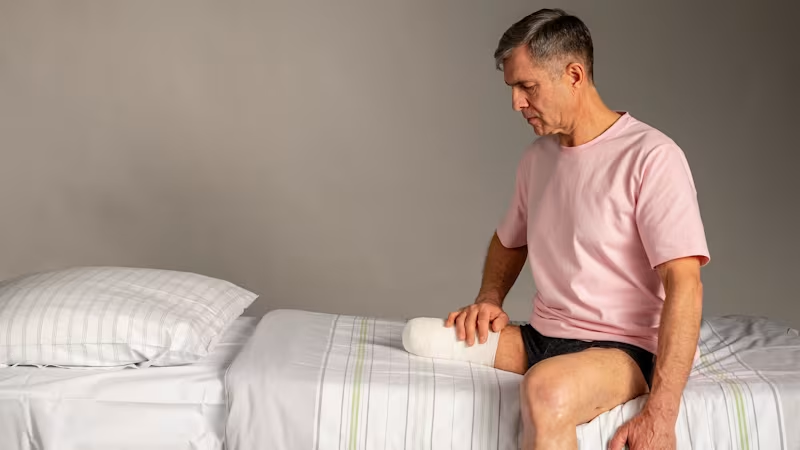
Mirror therapy: sitting in front of a mirror, the patient’s sound limb is reflected with the help of mirrors. This makes it appear as though the amputated limb is there again. Known as the phantom limb, it can now be moved purposely via the sound side and therefore influenced. This makes it possible to release the phantom limb from cramped and painful positions with the help of movements by the sound side, moving it into a more comfortable, pain-free position. Comparable results can be obtained by looking at photographs (known as lateralisation training). This is intended to practise right/left memory.
Sensorimotor therapy: massaging the residual limb with various materials stimulates nerves via the skin. Ultrasound, thermal or electrotherapy can be used here as well.
Wearing a prosthesis or liner: for many affected individuals, pain is alleviated by wearing a prosthesis or liner. This may be due to sensory stimulation of the residual limb as well as the idea that, with a prosthesis, the body part is still there so the brain is receiving corresponding feedback.
Pain therapy: a pain therapist is a doctor specialising in the treatment of pain. Your doctor will put you in contact with such a specialist. It’s important that you do not try to treat yourself with pain medication in any case.
Causes of phantom pain (1)
Experts have various theories regarding the origin of phantom pain. One of the most common ones is that different areas in the brain are responsible for different body regions. When a body part is missing and doesn’t produce any feedback anymore, the brain interprets this lack of a signal as pain. In this context, it’s interesting to note that people with a congenital limb difference, known as dysmelia, do not experience phantom pain as often. This suggests that there is a sort of “learning effect” in the brain. Pain memory appears to play an important role as well. If the patient was already experiencing pain before the amputation, this can affect the development of phantom pain and should also be taken into account in selecting the therapy.
Types of phantom pain (1)
Phantom pain is very individual and depends on many factors. It affects individuals with leg or arm amputations equally. The pain may be triggered or intensified by certain types of weather, exposure to cold temperatures or emotional stress. It may occur only at certain times, gradually decrease or increase, or always be present. The type, intensity and characteristics of the pain can differ as well. Affected individuals describe pulling and piercing or burning and cramp-like pain.
Phantom pain is different from phantom sensations, feelings in the lost limb that are not painful.
Therapy options for phantom pain (1)
Various kinds of pain may occur in the residual limb after an amputation. It is important to differentiate between residual limb pain and phantom pain, since these types of pain are treated differently.
There are many different therapy approaches for both types of pain. Combining several types of therapy is recommended for phantom pain. There is no standard therapy that helps all affected individuals. Furthermore, many therapies are of a long-term nature and require the active participation of the affected person. You may need a great deal of patience and endurance. But we can only encourage you to do the therapy, even if it is challenging. Be sure to talk to your doctor, O&P professional and therapist. They will work closely with you and support you to the best of their ability. The following methods are suitable means of therapy for phantom pain after an amputation and complement each other
Residual limb pain (1)
Residual limb pain and phantom pain are different types of pain and are therefore treated differently. For this reason, it’s important that you are thoroughly examined in order to determine whether you are experiencing phantom pain or another form of residual limb pain. Residual limb pain can also be caused by a poorly fitting prosthesis. Medical examinations help clarify whether you may have bothersome scar tissue, painful residual limb neuromas, inadequate soft tissue coverage or excess soft tissue. These causes of pain can be eliminated on a long-term basis by adapting the components or via another surgical intervention.
Certain operating techniques can also help reduce residual limb pain and especially the pain originating from some nerves in the residual limb after the amputation. If possible, preventive pain therapy should commence during the operation with a local anaesthetic or begin directly after the operation to prevent the onset of pain or the development of chronic pain.
4 results out of 4
Restez mobile (1)
Pendant que la cicatrisation de votre moignon est encore en cours, vous pouvez d’ores et déjà vous préparer à votre séjour au sein d’un centre de rééducation grâce à des exercices spécifiques. Parlez-en à votre médecin ou à votre kinésithérapeute et demandez-leur de vous montrer certaines choses importantes comme le positionnement correct dans le lit afin que les muscles et l’articulation la plus proche du moignon ne se raccourcissent ou ne se raidissent pas, ainsi que des exercices de respiration réguliers et des exercices physiques et de mobilisation simples, qui servent aussi à stabiliser le système cardiovasculaire. Ces mesures vous permettent d’être appareillé rapidement et facilement avec une prothèse pour rester mobile et actif.
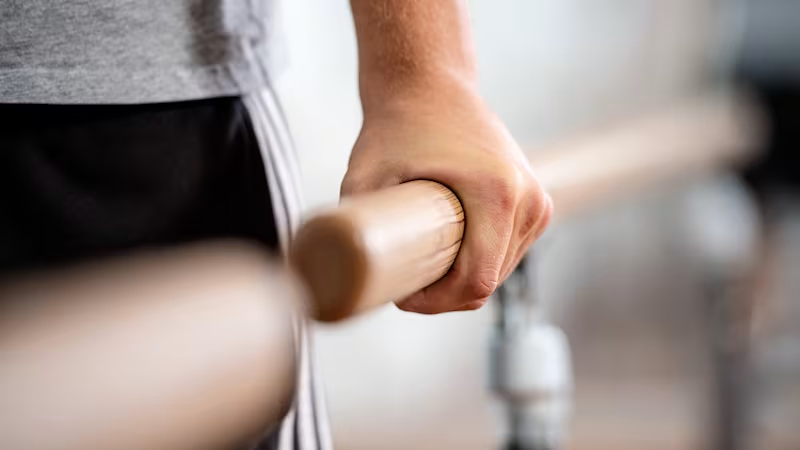
Comment trouver le bon centre de rééducation ? (1)
Après votre séjour à l’hôpital, vos soins se poursuivent en principe en clinique de rééducation, où vous serez préparé à utiliser votre prothèse de jambe au quotidien. Pour tirer le meilleur parti de ce séjour, il est conseillé de choisir un centre spécialisé dans la rééducation des personnes amputées.
Un centre de rééducation avec une grande expérience dans ce domaine peut mieux répondre à vos besoins. On estime qu’il s’agit des centres qui prennent en charge au moins 50 patients par an. Demandez au centre de votre choix son nombre annuel de patients.
Consultez votre orthoprothésiste, il peut aussi vous aider à faire le bon choix.
Votre médecin vous explique à partir de quand votre séjour dans un centre de rééducation peut être envisagé et si votre rééducation sera stationnaire ou ambulatoire. Ces décisions sont prises en fonction de nombreux facteurs tels que les progrès de la guérison et vos possibilités de préparation chez vous.
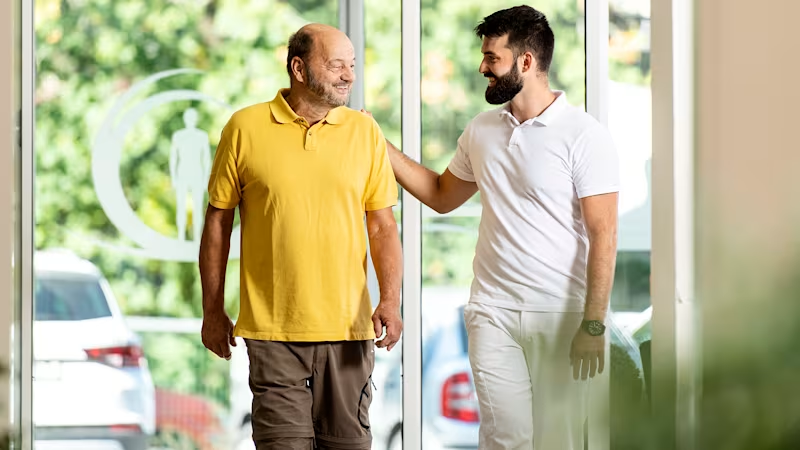
The process of getting a prosthesis (1)
After your amputation, you will have many urgent questions: When will I get a prosthesis, how do I get a prosthesis and which prosthesis will I get? We want to provide you with all the details about the next steps here.
Generally speaking, your prosthesis fulfils numerous functions: On the one hand, it restores your mobility to a large extent. By wearing a prosthesis, you also reduce or avoid posture problems and balance disorders that could result because of the missing weight of the amputated leg. It also prevents your sound leg from being overloaded, which could result in problems over the long term. Talk to your O&P professional right after the amputation. They can explain the process leading up to your fitting with a prosthesis. Please note that many factors determine when you get a prosthesis and whether you are first fitted with an interim (temporary) prosthesis. Your O&P professional can give you detailed advice.
